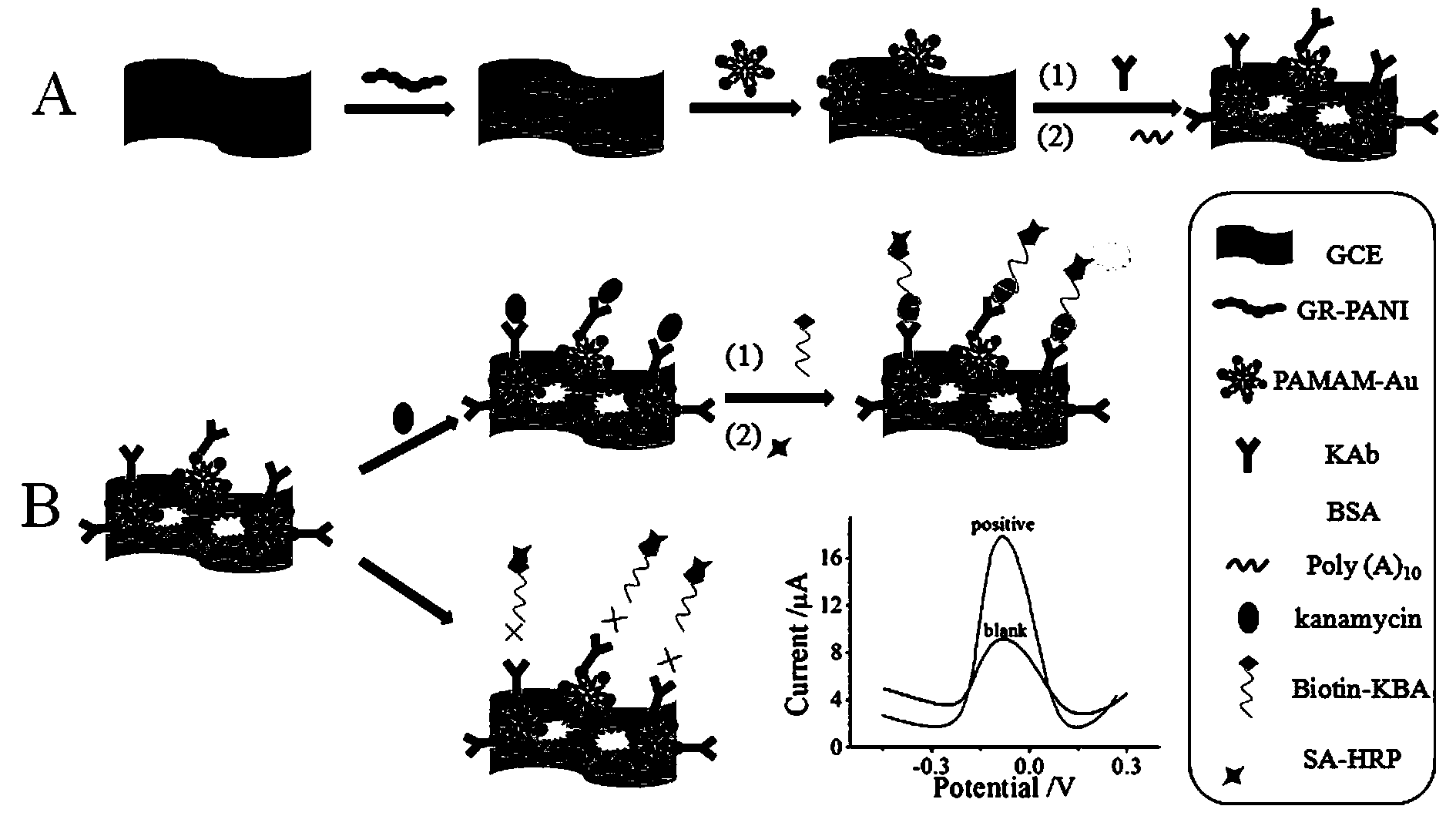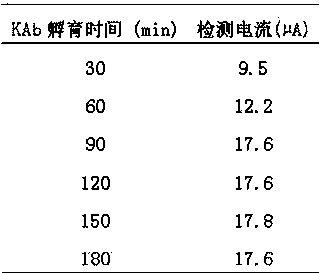Electrochemical aptamer electrode for kanamycin detection and preparation method of electrochemical aptamer electrode
A kanamycin and electrochemical technology is applied in the field of detection sensors to achieve the effects of fast online detection, sensitive detection and simple operation
- Summary
- Abstract
- Description
- Claims
- Application Information
AI Technical Summary
Problems solved by technology
Method used
Image
Examples
preparation example Construction
[0040] (1) Preparation of graphene oxide (GO):
[0041] Graphene oxide (GO) was prepared according to classical methods. Briefly, 1.0 g of graphite powder was added to 0.5 g of sodium nitrate (NaNO 3 ) and 3.0 g potassium permanganate (KMnO 4 ) with a mass fraction of 98% in 50 mL of concentrated sulfuric acid (H 2 SO 4 )middle. When the temperature is lower than 20 °C, react for 1 h, then raise the temperature to 35 °C, and continue to stir for 30 min. Then slowly add about 100 mL of ionized water, and after stirring continuously for 20 min, add 50 mL of H 2 o 2(30%), to reduce the residual oxidant, the solution gradually turned bright yellow; filtered while hot, washed with HCl solution and deionized water until no sulfate was detected in the filtrate. The precipitate was dried in a thermostat at 60 °C to obtain GO.
[0042] (2) Synthesis of graphene-polyaniline (GR-PANI) composite
[0043] 2.75 mL of aniline (99%) dissolved in 100 mL of 1 mol L -1 The concentratio...
Embodiment 1
[0049] A method for preparing a sandwich type electrochemical sensor of the present invention, comprising the following steps:
[0050] a. The glassy carbon electrode is first polished in 0.3 and 0.05??m alumina slurry until it becomes a mirror surface, and then rinsed with secondary water;
[0051] b. Add 10 μL of the prepared GR-PANI dropwise on the surface of the electrode and dry it at room temperature overnight; the modified electrode is immersed in the prepared PAMAM-Au solution and kept for 3 h;
[0052] c. After washing several times with secondary water, dissolve 5 μmol L in 10 μL -1 Add the PBS solution of Kanamycin Antibody (KAb) dropwise on the surface of the electrode, keep it at room temperature for 90 min, rinse the electrode with secondary water and PBS to remove unbound KAb;
[0053] d, 10 μL BSA (0.1%) and poly(A) 10 Strand (single-stranded DNA with 10 adenine bases, 5 μmol L -1 ) is used to block the unbound sites on the electrode surface, that is, a sand...
Embodiment 2
[0061] Dissolve 5 μmol L in 10 μL -1 Add the PBS solution of Kanamycin antibody (KAb) dropwise on the surface of the electrode, change the incubation time (30, 60, 90, 120, 150, 180 min) at room temperature, and rinse the electrode with secondary water and PBS to remove unbound KAb, making different electrodes, used to select the best incubation time of KAb, the others are the same as in Example 1.
[0062]
PUM
| Property | Measurement | Unit |
|---|---|---|
| thickness | aaaaa | aaaaa |
| thickness | aaaaa | aaaaa |
| thickness | aaaaa | aaaaa |
Abstract
Description
Claims
Application Information
 Login to View More
Login to View More - R&D
- Intellectual Property
- Life Sciences
- Materials
- Tech Scout
- Unparalleled Data Quality
- Higher Quality Content
- 60% Fewer Hallucinations
Browse by: Latest US Patents, China's latest patents, Technical Efficacy Thesaurus, Application Domain, Technology Topic, Popular Technical Reports.
© 2025 PatSnap. All rights reserved.Legal|Privacy policy|Modern Slavery Act Transparency Statement|Sitemap|About US| Contact US: help@patsnap.com



